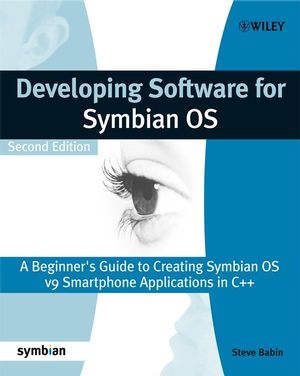Developing Software for Symbian OS: A Beginner's Guide to Creating Symbian OS V9 Smartphone Applications in C++, 2nd EditionISBN: 978-0-470-72570-2
Paperback
460 pages
November 2007
 This title is out-of-print and not currently available for purchase from this site.
|
Foreword (Warren Day)
Biography.
Author Acknowledgments.
Symbian Press Acknowledgments.
Symbian OS Code Conventions and Notations Used in the Book.
1. Smartphones and Symbian OS.
1.1 Notes on this New Edition.
1.2 Smartphone Concepts.
1.3 Smartphone Features.
1.4 The Mobile OS.
1.5 Symbian OS – A Little History.
1.6 Symbian OS Smartphones.
1.7 Other Smartphone Operating Systems.
2. Symbian OS Quick Start.
2.1 What Do You Need to Get Started?
2.2 Firing Up the Development Tools.
2.3 Simple Example Application.
2.4 Building and Executing on the Emulator.
2.5 A Carbide.c++ Project.
2.6 Building for the Smartphone.
3. Symbian OS Architecture.
3.1 Components in Symbian OS.
3.2 Multitasking in Symbian OS.
3.3 Shared Code: Libraries, DLLs, and Frameworks.
3.4 Client-Server Model.
3.5 Memory in Symbian OS.
3.6 The Kernel.
3.7 Active Objects and Asynchronous Functions.
3.8 GUI Architecture.
3.9 High-Performance Graphics.
3.10 The Communication Architecture.
3.11 Application Engines and Services.
3.12 Platform Security.
4. Symbian OS Programming Basics.
4.1 Use of C++ in Symbian OS.
4.2 Non-standard C++ Characteristics.
4.3 Basic Data Types.
4.4 Symbian OS Classes.
4.5 Exception Error Handling and Cleanup.
4.6 Libraries.
4.7 Executable Files.
4.8 Naming Conventions.
4.9 Summary.
5. Symbian OS Build Environment.
5.1 SDK Directory Structure.
5.2 Build System Overview.
5.3 Basic Build Flow.
5.4 Build Targets.
5.5 What is a UID?
5.6 The Emulator.
5.7 Building Shared Libraries.
5.8 DLL Interface Freezing.
5.9 Installing Applications on the Smartphone.
6. Strings, Buffers, and Data Collections.
6.1 Introducing the Text Console.
6.2 Descriptors for Strings and Binary Data.
6.3 The Descriptor Classes.
6.4 Descriptor Methods.
6.5 Converting Between 8-Bit and 16-Bit Descriptors.
6.6 Dynamic Buffers.
6.7 Templates in Symbian OS.
6.8 Arrays.
6.9 Other Data Collection Classes.
7. Platform Security and Symbian Signed.
7.1 What is Platform Security?
7.2 What Platform Security is Not.
7.3 What this Means to a Developer.
7.4 Capabilities for API Security.
7.5 Application Signing in Symbian.
7.6 Getting Your Application Symbian Signed.
7.7 Developer Certificates.
8. Asynchronous Functions and Active Objects.
8.1 Asynchronous Functions.
8.2 Introducing Active Objects.
8.3 The Active Scheduler.
8.4 Active Scheduler Error Handling.
8.5 Active Object Priorities.
8.6 Canceling Outstanding Requests.
8.7 Removing an Active Object.
8.8 Active Object Example.
8.9 Active Object Issues.
8.10 Using Active Objects for background Tasks.
9. Processes, Threads, and Synchronization.
9.1 Processes.
9.2 Using Threads on Symbian OS.
9.3 Sharing Memory Between Processes.
9.4 Memory Chunks.
9.5 Thread Synchronization.
10. Client-Server Framework.
10.1 Client-Server Overview.
10.2 A Look at the Client-Server Classes.
10.3 Client-Server Example.
11. Symbian OS TCP/IP Network Programming.
11.1 Introduction to TCP/IP.
11.2 Network Programming Using Sockets.
11.3 Symbian OS Socket API.
11.4 Example: Retrieving Weather Information.
11.5 Making a Network Connection.
12. GUI Application Programming.
12.1 Symbian OS User Interfaces.
12.2 Anatomy of a GUI Application.
12.3 Application Classes.
12.4 Resource Files.
12.5 Dialogs.
12.6 Symbian OS Controls.
12.7 View Architecture.
12.8 Application Icon and Caption.
References.
Index.



